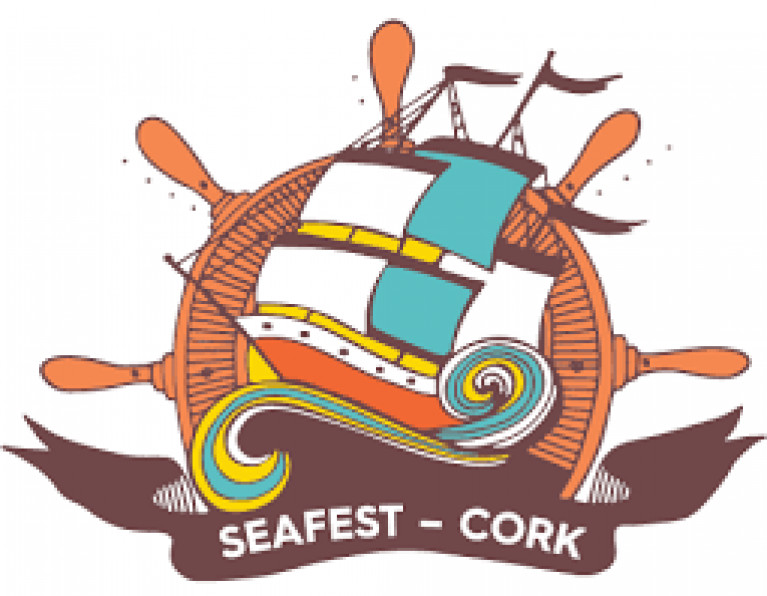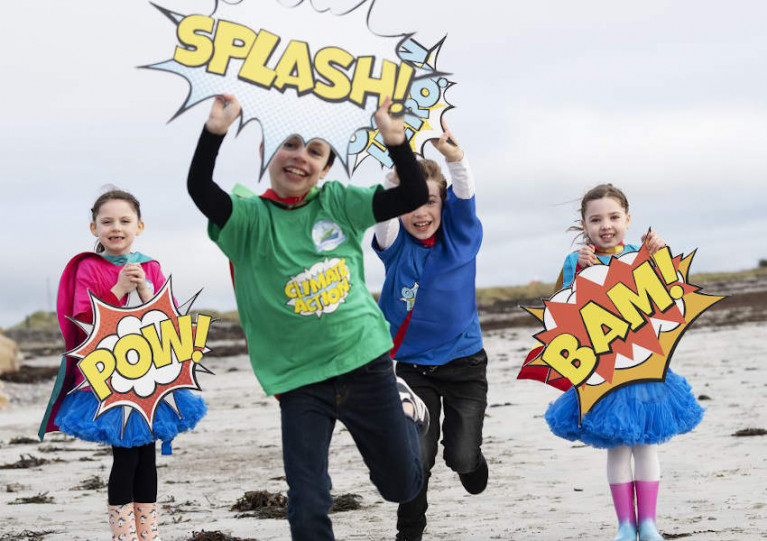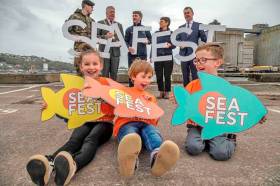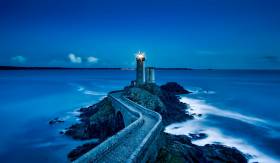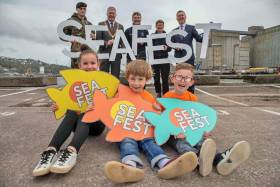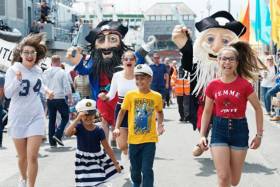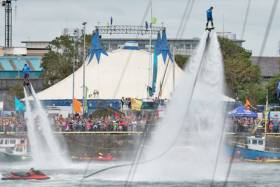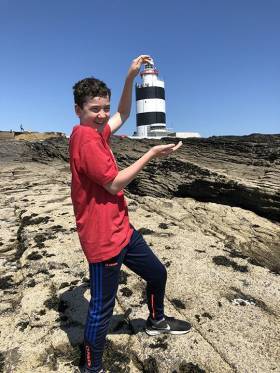Displaying items by tag: seafest
In recognition of European Maritime Day on 20th May and World Oceans Day on 8th June, the Marine Institute and partners will celebrate our seas, our world’s shared ocean and our connection to the sea through our Oceans of Learning series. Over the next 10 weeks, the Marine Institute and partners will come together virtually and share news and offer online activities and resources on a range of marine topics to make it easier for those of all ages to engage with our ocean from home.
European Maritime Day aims to raise awareness about the seas and oceans and their importance to our environment, economy and culture, with the annual event offering workshops, networking, discussions and the opportunity to forge joint action on maritime affairs and the blue economy. The 2020 European Maritime Day conference was to take place this May in Cork City, alongside Ireland’s national maritime festival SeaFest.
Minister for Agriculture, Food and the Marine, Michael Creed said: “While we regret that this year’s European Maritime day events in Cork had to be cancelled, public health concerns must take priority at this time. Following a period during which the marine sector had been enjoying a period of increased growth, the main challenge facing the sector for the foreseeable future will be recovery from the economic impacts of the current public health crisis. This will require all relevant stakeholders to work together to ensure that the momentum for sustainable growth is maintained over time”. The Oceans of Learning 2020 Campaign - One Shared Ocean - One Shared Future will showcase some of the positive developments across the marine sector in recent years which we will need to build on as we face these new and unexpected challenges.”
Lord Mayor of Cork, Cllr. John Sheehan said: "While it is with great disappointment that we were unable to host European Maritime Day 2020 and the SeaFest National Maritime Festival this year, health and safety of all participants and those attending is paramount. Despite the disappointment of the cancellations, the key messages around the importance our Oceans and the role they play in our lives still stands, and I am delighted this will be celebrated through our Oceans of Learning Series to be hosted by the Marine Institute. We look forward to welcome SeaFest back to Cork in 2021.”
Dr Paul Connolly CEO of the Marine Institute said: “Planning for the European Maritime Day event and SeaFest brought together partners in Cork, nationally and internationally. We want to take this opportunity to come together to celebrate our seas and look at the enormous opportunities presented by our coast and ocean. Through our Oceans of Learning series, the Marine Institute with our partners, will offer a host of resources on our shared ocean and the major role it plays in our everyday lives. Our ocean has sustained us in good times and in bad. Now more than ever we must come together and empower Ireland and its people to safeguard and harness our ocean wealth.”
Ireland’s marine resource is ten times the size of its land territory, supports diverse ecosystems, is a source of food, and influences our climate, weather and our wellbeing. Our ocean has an important role in Ireland’s economy, providing employment in a number of areas of the marine sector – fisheries, aquaculture, ports and shipping, technology, tourism and seafaring.
Each week through our Oceans of Learning series we will share a new marine topic - from the food we take from our ocean, and our rich marine biodiversity, to our changing ocean climate, and ports and shipping.
The Marine Institute will work with Government Departments and partners such as Bord Iascaigh Mhara, Bord Bia, National Maritime College Ireland, The Commissioners of Irish Lights, Met Éireann, Marine and Renewable Energy Ireland (MaREI) and coastal communities and organisations across Ireland to enable everyone to engage with our ocean from anywhere.
The first marine topic in our Oceans of Learning series is ‘Food from our Ocean’ and will be available on www.marine.ie next week.
The Covid-19 virus has forced the cancellation of SeaFest, the national maritime festival which was due to take place in Cork in May.
In a statement, the Marine Institute said that a decision was taken to postpone the event until 2021 “in light of the rapidly evolving situation and public health measures due to the coronavirus”
The festival, which was returning to Cork after several years in Galway, was due to take place from May 15th to 17th.
It has drawn record crowds since its initiation, earning a title of the “national ploughing championships of the sea“
European Maritime Day Deferred
The Marine Institute said that European Maritime Day, which was also scheduled to take place in Cork to coincide with “SeaFest”, has also been deferred and new dates are being considered for it.
“In taking this decision our priority was to ensure the health and wellbeing of both exhibitors and visitors at the event,” the Marine Institute said in a statement on Monday afternoon.
"We looked forward to welcoming everyone to SeaFest in 2021," it said.
Primary school children across Ireland are being invited to use the power of their imagination to save the ocean from climate change in a new art and writing competition.
The Explorers Pop Art & Creative Writing Competition was launched earlier this week by the Marine Institute’s Explorers Education Programme.
“By bringing science, art and creative writing together, the aim of the ‘ocean superhero’ competition is to cultivate the children's imagination, creating new ideas and solutions when addressing issues of environmental care and climate change,” said Cushla Dromgool-Regan, Explorers Education manager from Camden Education Trust who is co-ordinating the contest.
“The idea of creating an ocean superhero aims to help create a sense of hope for children at a time of adversity in the world, when the impacts of climate change can seem extremely challenging.”
The winners will see their art work and stories showcased as part of the Marine Institute exhibit at SeaFest, Ireland’s largest maritime festival, from 14-17 May.
A shortlist of VIP winning classes will be invited to visit the Marine Institute’s research vessel and its exhibition at Seafest, where they will get to meet world-leading speakers and scientists who are all working towards Ireland’s challenge in responding and adapting to climate change.
The Explorers Education Programme website has more information about the competition, including details of how to enter.
Thousands Flock To This Year’s SeaFest in Cork
Ireland’s largest free family-friendly maritime celebration attracted thousands of visitors to the port and city of Cork this past weekend.
Cork was transformed into a giant interactive ‘sea world’ for the three days of SeaFest 2019, and the port was awash with non-stop activities and entertainment for all ages.
Visitors to the Marine Institute’s Wild Atlantic Theatre were treated to exciting talks and shows with award-winning wildlife cameraman Doug Allan, filmmaker Ken O’Sullivan and Met Éireann’s head of forecasting Evelyn Cusack.
Ireland’s maritime history was also in focus with a seminar on the antiquity and sustainability of curraghs, as Tom MacSweeney writes.
And the side of the R&H Hall building in Cork Harbour was transformed with an enormous depiction of the ‘Real Map of Ireland’ which takes into account the State’s significant seabed territory.
All the events during SeaFest were free for festival-goers. There were open tours available on a number of vessels in the ship-filled harbour including State research vessel RV Celtic Explorer — fresh off its annual ocean climate research survey to collect high-quality oceanographic data for the Atlantic Ocean Observing System.
The festival, which was held in Galway for the last few years, concluded yesterday (Monday 10 June) with the Ocean Wealth Summit which featured special guests John Kerry, the former US Secretary of State, and the presidents, foreign ministers or UN ambassadors of 31 small island developing states.
SeaFest 2019 also saw the official launch of EurofleetsPlus, the programme to facilitate access to the largest advanced research vessel fleet across Europe, Greenland, the USA and Canada, Bermuda and New Zealand — providing a significant increase in ship-time at sea.
The programme will now move towards its competitive call phase, including SEA (ship-time and marine equipment application) which will have an ‘Ocean’ call, due to open this month, and a ‘Regional’ call in September.
Sea Change At Seafest: Ireland’s Largest Free Maritime Festival To Raise Awareness Of Plastic Pollution
An interactive hut made up of 60kg of household plastics — the average amount used by an adult in Ireland each year — will be unveiled at SeaFest this weekend, highlighting the problem of plastics in our oceans.
Ireland’s largest free family-friendly maritime festival begins at the Port of Cork from today, Friday 7 June, and continues to this Sunday 9 June with over 100 free events celebrating our oceans.
More than 100,000 visitors are expected to attend SeaFest, which is presented by Cork City Council and the Inter-Departmental Marine Coordination Group (MCG).
Raising awareness of the need to protect our marine environment against plastic pollution, Bord Iascaigh Mhara's centrepiece at SeaFest is the Clean Oceans Experience.
Funded by the European Maritime and Fisheries Fund, the installation includes a 60kg plastic hut sculpture, representing the total plastic packaging waste produced per person in a year.
This installation will be accompanied by a specially commissioned artistic performance, Fantastic Fishermen Go Fishing for Litter, on how the fishing sector is reducing plastics in our seas.
Members of the fishing sector taking part in BIM's Fishing for Litter scheme, which encourages fishermen to take ashore waste they encounter at sea, have collected over 330 tonnes of marine litter since it began in 2015.
“Environmental stewardship of our oceans is something we need to instil in our children”
“Environmental stewardship of our oceans is something we need to instil in our children,” Lord Mayor of Cork, Councillor Mick Finn, said. “This will ensure the problems facing our oceans are addressed, and hopefully, reversed.
“I’m delighted to welcome SeaFest to Cork for the next three years, as it serves an important role in this education. SeaFest is a brilliant illustration of our unique and unrivalled maritime history.
“In a fun and interactive way, this national annual festival is helping those of all ages to think about their connection with the water and how the actions they make today can make a difference tomorrow.”
Engaging exhibitions and workshops to turn plastic into art also feature at SeaFest, open daily from 10am to 6pm.
A Flock of Sea Gulls will see 1,000 young visitors transform 1,000 plastic cartons into an installation of seagulls, while the Port of Cork and MaREI’s 3D exhibition, Maintaining a Healthy Harbour, is also on display, with marine litter artworks from local school children.
Showing how our oceans and climate are linked, the Marine Institute’s Wild Atlantic Theatre features talks from Met Éireann’s head of forecasting Evelyn Cusack and wildlife cameraman Doug Allan.
Doug, who has worked alongside Sir David Attenborough on BBC’s Blue Planet and Frozen Planet, will discuss how changing climate is affecting Earth's north and south regions.
Sustainably sourced Irish seafood plays a starring role at SeaFest
Sustainably sourced Irish seafood plays a starring role at SeaFest with demos from top chefs Nevin Maguire, Rory O'Connell and Martin Shanahan.
The Bord Bia and BIM Seafood Experience also features fishmongers Pat O’Connell and Hal Dawson on seafood preparation.
Encouraging responsible activity on the water, SeaFest will hold free sailing, kayaking, and currach boats sessions, along with interactive displays exploring the marine world.
Speaking ahead of SeaFest 2019, Marine Minister Michael Creed said: “SeaFest is part of Harnessing Our Ocean Wealth, the Government’s integrated plan for the marine sector. A key aspect of this plan is to significantly increase our level of engagement with the sea.
“As we welcome the festival back to Cork from Galway where it has been thriving over the past three years, once again, SeaFest has delivered a fantastic line-up of free, educational and fun events to engage both the public and policy makers alike and emphasise the importance of Ireland’s marine economy.”
Providing education on our oceans, the Marine Institute's RV Celtic Explorer is open to the public, following its oceanographic data collection voyage from Galway to Cork.
There will also be vessel tours of Commissioners of Irish Lights’ ILV Granuaile and tall ship Phoenix.
MFV Allanah Riley, a white fish trawler that fishes out of the port of Castletownbere, will be open to visitors throughout SeaFest. Its crew will be on hand to explain the sustainable fishing practices of the Irish fishing fleet.
Market traders will be using compostable packaging across the weekend
As part of Cork City Council’s commitment to green initiatives, Cork City Council environmental awareness officer Mary Walsh highlighted that market traders will be using compostable packaging across the weekend.
“There will also be pirates on site, keeping SeaFest free from single-use plastics. If someone has brought a plastic bottle with them, the pirate will show them how, and where, to dispose of it,” she said.
SeaFest 2019 is a culmination of a weeklong celebration of Ireland’s rich maritime heritage, as the annual Cork Harbour Festival runs until Sunday 9 June.
The Our Ocean Wealth Summit takes place in Cork on Sunday 9 and Monday 10 June. The summit will hear from global leaders including environmental activist and former US Secretary of State John Kerry.
To view the full festival programme visit SeaFest.ie. Follow SeaFest on Facebook, Twitter and Instagram and use the hashtag #SeaFest19.
SeaFest is proudly supported by Cork City Council, BIM, Marine Institute, Port of Cork, Cork Harbour Festival, Commissioners of Irish Lights, Defence Forces, Department of Agriculture, Food and the Marine, Department of Foreign Affairs and Trade, Bord Bia, Sea Fisheries Protection Authority, Pure Cork and by media partners Today FM and RedFM.
Seafest is co-funded by the Government of Ireland and the European Union under Ireland’s European Maritime & Fisheries Fund Operational Programme for the seafood sector.
Famous buildings and landmarks across Ireland will ‘Go Atlantic Blue' over the weekend 7-10 June to celebrate our connection to the Atlantic Ocean as part of World Oceans Day.
The global day this Saturday 8 June connects people worldwide in celebrating the ocean, its importance in our lives and how each of us can protect it, no matter where we live.
In Ireland, more than 20 different landmarks are expected to participate in the day by lighting up their buildings.
Businesses, shops, schools and homes across the country will also ‘Go Atlantic Blue’ on the day also being celebrated by the likes of surfing scientist Easkey Britton, who spoke recently to Independent.ie about her own oceanic connections.
Everyone’s participation will highlight the strong connection that people in Ireland have with the Atlantic Ocean and the multiple ways that it affects and enriches our daily lives.
‘Go Atlantic Blue’ is being spearheaded in Ireland by the Marine Institute-led AORA-CSA (Atlantic Ocean Research Alliance Co-ordination & Support Action) against the backdrop of SeaFest 2019 and the Our Ocean Wealth Summit, both taking place in Cork in the coming days.
SeaFest is Ireland’s national maritime festival and Our Ocean Wealth Summit is Ireland’s flagship event for the marine sector, bringing together Irish and international organisations to create innovative and sustainable solutions to drive our Blue Economy.
This is the first year to ‘Go Atlantic Blue’ with the aim of raising awareness of the vital role that the Atlantic Ocean plays in the lives of Irish people, no matter how near or far they live from the Atlantic coastline.
Among the activities that AORA promotes through its work are the development of an ‘Atlantic community’, made up of citizens of countries that neighbour the Atlantic Ocean, and also exploring, observing and mapping the remainder of the Atlantic Ocean floor (which AORA calls “the last great exploration campaign on Earth”).
“Our ocean is our greatest natural resource and we see that most directly in Ireland with the vital importance that the Atlantic Ocean plays in our daily lives”
Marine Institute chief executive Dr Peter Heffernan said: “Our ocean is our greatest natural resource and we see that most directly in Ireland with the vital importance that the Atlantic Ocean plays in our daily lives — from influencing the weather to facilitating our trade industry and from seafood to surfing off the coast.
“The Marine Institute is proud to support the ‘Go Atlantic Blue’ initiative from 7-10 June, particularly at SeaFest and Our Ocean Wealth Summit, and we encourage and welcome everyone to come onboard.”
Dr Margaret Rae, director of AORA-CSA, said that the initiative gives people all around the country a chance to show their appreciation for the Atlantic Ocean.
“In Ireland, the Atlantic Ocean means so much to us. It’s our largest natural resource and we draw so much from it — our livelihoods, food, bounty, beauty, imagination, inspiration, song, poetry, health and wellbeing and much much more.
“Going Atlantic Blue is a way to draw attention to how each and every one of us experiences the Atlantic, what we love about our ocean and how we can be that generation that makes a difference.”
SeaFest is returning to Cork city this summer — and Ireland’s largest free family-friendly maritime celebration unveils its exciting 2019 programme with over 100 events taking place from 7-9 June.
Some 100,000 visitors are expected at the Port of Cork for SeaFest 2019, with the line-up to include cooking demonstrations from celebrity chefs Neven Maguire and Rory O’Connell and talks from Met Éireann’s Evelyn Cusack and wildlife cameraman Doug Allan.
Held in Galway for the past three years, SeaFest is relocating back to Cork — where the first edition was held in 2015 — in a move that will see the Rebel City host the event annually to 2021.
The festival, which acknowledges everything the ocean has to offer, will be a culmination of a weeklong celebration of Ireland’s rich maritime heritage as the annual Cork Harbour Festival runs from 1–9 June.
SeaFest highlights include Bord Iascaigh Mhara (BIM) and Bord Bia free cookery demonstrations from esteemed chefs Rory O’Connell (Ballymaloe Cookery School) and Neven Maguire (MacNean House & Restaurant), along with demos from fishmongers, Pat O’Connell and Hal Dawson. BIM also brings its never-before-seen Clean Oceans visitor experience, raising awareness of plastic in our oceans.
Further key events for SeaFest 2019 include Met Éireann head of forecasting Evelyn Cusack discussing weather changes and warnings at the Marine Institute marquee.
There will also be engaging talks and films inspired by the ocean at the Marine Institute’s Atlantic Theatre. Award-winning wildlife cameraman Doug Allan will discuss his remarkable experiences filming BBC’s Blue Planet and Ocean Giants. RTÉ documentary Ireland’s Deep Atlantic will also be screened.
Speaking on the launch, Lord Mayor of Cork Mick Finn said: “SeaFest is a hugely important festival for the country and it’s fitting that it will take place in Cork which has a unique maritime history and association with the sea. That the city’s motto proclaims Cork to be ‘a safe harbour for ships’ speaks for itself.
“There is a great programme of free events lined up for the festival this year — and for the next three years — to ensure that people connect with the river, the harbour and the sea.
“SeaFest will be at the core of European Maritime Day next year when we will also celebrate 300 years of the Royal Cork Yacht Club, the oldest of its kind in the world. We invite everyone to attend the free, fun events and help focus on keeping our oceans healthy and vibrant.”
There will be free sailing, kayaking, currach and dragon boat trips on the water with Irish Sailing, Atlantic Sea Kayaking and Meitheal Mara.
Tours of the Marine Institute’s research vessel RV Celtic Explorer and the Commissioner of Irish Lights’ ILV Granuaile take place across the weekend. And the Defence Forces will provide an equipment and capabilities display.
Marine Minister Michael Creed said: “SeaFest is about highlighting the importance and value of our seas and oceans. After being successfully hosted in Galway for the last three years, it is important that this national maritime festival is enjoyed across the country.
“I am delighted therefore that it will be presented in Cork city for the next three years from 2019-21, as it continues to grow and evolve and in other coastal locations in the future.
“With such a fantastic line-up of free and fun events across the three days designed to educate, engage and entertain the whole family, SeaFest 2019 in Cork is set to be a magnificent maritime celebration.”
There will be fun and free activities in the dedicated Kids Zone, along with touch tank displays as part of the Marine Institute’s Explorers Education Programme.
This is the first year for BIM’s interactive aquaculture remote classroom (ARC) at SeaFest, with virtual reality headsets for wearers to experience mussel beds up close. Music Generation Cork City will also be performing on the music stage throughout the event.
The Port of Cork and UCC research centre MaREI will showcase a 3D art exhibition by local fifth class pupils about awareness of marine litter. In addition, the Department of Foreign Affairs and Trade will outline UN Sustainable Development Goals, and there will be water safety advice from RNLI.
SeaFest 2019 is part of Harnessing Our Ocean Wealth, increasing our engagement with the sea. The Our Ocean Wealth Summit will take place in Cork on Sunday 9 and Monday 10 June.
SeaFest is proudly supported by Cork City Council, BIM, Marine Institute, Port of Cork, Cork Harbour Festival, Commissioners of Irish Lights, Defence Forces, Department of Agriculture, Food and the Marine, Department of Foreign Affairs and Trade, Bord Bia, Sea Fisheries Protection Authority, Pure Cork and by media partners Today FM and RedFM.
SeaFest is part-funded by the Government of Ireland and the European Union under Ireland’s European Maritime & Fisheries Fund Operational Programme for the seafood sector.
To view the full festival programme visit SeaFest.ie, and keep up with the latest updates on Facebook, Twitter and Instagram.
SeaFest Nominated For National Event Industry Award
#SeaFest - SeaFest has been nominated for two awards in the Event Industry Awards 2018.
The 2017 edition of Ireland’s national maritime festival has been shortlisted for ‘Best Live Event’ and ‘Best Cultural Event’ in this year’s awards, with the overall winners set to be revealed next Friday 20 July.
The Event Industry Awards is the premier awards ceremony for the event sector in Ireland, and showcases the highest standards in Ireland’s event industry.
Sinéad Coyne, communications manager for the Marine Institute and SeaFest, said: “We are really delighted and honoured to be shortlisted for two categories in this year’s Event industry Awards alongside so many well-established companies. Congratulations to everyone involved and we look forward to the awards ceremony on July 20th at Citywest Hotel, Dublin.”
SeaFest creates awareness of Ireland’s maritime heritage and celebrates the many ways our seas and oceans enrich our lives.
A relative newcomer to the festival scene in Ireland, SeaFest has quickly become one of the most popular events in the country. Now in its fourth year, the festival has grown in attendance and scope – attracting 10,000 visitors in 2015, 60,000 visitors in 2016 and more than 100,000 visitors this year.
All entertainment, events and activities at SeaFest are free, and 103,000 visitors flocked to Galway Harbour to enjoy a host of activities and entertainment on and around the water from Friday 29 June to Sunday 1 July. In addition, the festival generated over €6.5 million in direct income for Galway’s tourism industry.
Global event specialists Arcana were appointed event managers for SeaFest and worked with the Marine Institute and over 20 local, regional and national organisations and agencies to stage the three-day festival.
SeaFest 2018 Features In This Wednesday’s RTÉ Nationwide
#OnTV - RTÉ One’s Nationwide will devote this Wednesday’s episode to this year’s SeaFest, Ireland’s national maritime festival, which welcomed over 100,000 visitors to Galway over the weekend.
Presenter Mary Kennedy spent a couple of days in Galway Harbour, talking to some of the key figures involved in the festival and enjoying some of the activities and events on offer.
She interviewed famous wildlife cameraman Doug Allan, who has captured amazing footage on documentaries including Blue Planet, Frozen Planet and Ocean Giants. Doug was at SeaFest all weekend to give talks about his experiences filming in some of the wildest and most remote places on earth.
The programme will feature an interview with Irish underwater cameraman Ken O’Sullivan. His documentary Ireland’s Deep Atlantic on RTÉ captured the attention of the nation with groundbreaking footage of sea creatures in Irish waters.
Nationwide also met with Marine Institute chief executive Dr Peter Heffernan, who spoke about the marine economy and last week’s Our Ocean Wealth Summit, as well as some of the technology innovations highlighted at the Marine Ireland Trade Show during the festival.
SeaFest features on Nationwide this tomorrow evening (Wednesday 4 July) on RTÉ One at 7pm, and will be available to watch online via RTÉ Player for 28 days afterwards.
The Sun is Shining and We have a Winner! - ‘Great Lighthouse, Great Fun’ Photography Competition
#Lighthouses - It is more than eight weeks ago when Bobby Kerr, Chair of Great Lighthouses of Ireland helped kick off summer in fine style when he announced the ‘Great Lighthouse, Great Fun’ photography competition.
The competition was held to invite all to discover the amazing coastlines of Ireland, the challenge was simple: take a photograph that best captures and expresses the best of summer fun at a lighthouse.
“We had a huge number of entries, all a fantastic reflection of Ireland in summer... it was a challenging task for our judges to select (a) final ten, then five and (lastly) the winner,“ Kerr said.
“The winning image of Gar Heffernan holding Hook (Lighthouse) in his hands captured the essence of summer fun at our lighthouses. Well done, Gar. We look forward to meeting you,” said Kerr.
Gar and his family will enjoy a fantastic bespoke Great Lighthouses of Ireland experience for four people, which will include:
- A two-night stay at any of the Great Lighthouses of Ireland self-catering houses
- A personal tour with our leading storykeeper at any of our lighthouse attractions
- A unique opportunity to meet the Irish Lights historian at Howth’s Baily Lighthouse to learn all about the history and heritage of Irish Lights
- A chance to meet the Irish Lights team and learn more about how navigational aids work today
Speaking from SeaFest, Galway, Yvonne Shields, Chief Executive of Irish Lights said: “We look forward to welcoming our ‘Great Lighthouse, Great Fun’ winner and guests to Irish Lights to see the work involved in ensuring safe navigation around the coast of Ireland and (to) meet the team, whose technical and engineering expertise contributes to the development of our maritime economy. This weekend, we encourage all to come on board the Granualie at Seafest.” (See related ships on show tours).
Great Lighthouses of Ireland is an exciting collaboration between many private and public organisations in coastal communities, led and supported by Irish Lights. For event details and information about and booking Great Lighthouses of Ireland, see: www.greatlighthouses.com/shine-a-light
Twitter: @gtlighthouses | https://twitter.com/gtlighthouses
Facebook: @greatlighthousesofireland | https://www.facebook.com/greatlighthousesofireland
For full details and the competition terms and conditions, click this link here.





























